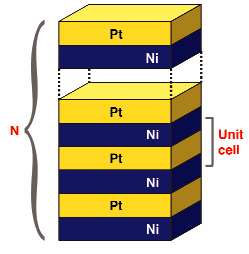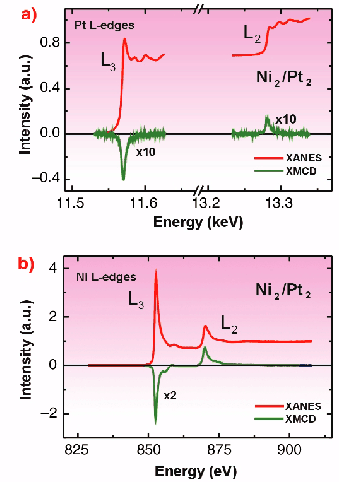- Home
- Users & Science
- Scientific Documentation
- ESRF Highlights
- ESRF Highlights 2000
- Magnetism
- Monolayer-resolved Magnetic Moment Profile in Ni/Pt Multilayers
Monolayer-resolved Magnetic Moment Profile in Ni/Pt Multilayers
Magnetic multilayers constitute a new class of materials exhibiting novel phenomena for basic and applied science. Usually, they are produced by a periodic repetition in one dimension of a unit cell consisting of a small number of monolayers (ML) of a ferromagnetic and a non-ferromagnetic element (Figure 82). Hybridisation effects, strain and reduced coordination numbers at the interfaces of multilayers modify the magnetic behaviour with respect to the bulk. In addition, remarkably, the non-ferromagnetic element acquires an induced magnetic moment. The magnetic properties of multilayers depend essentially on the layer-dependent distribution of the magnetic moments of both elements. Progress in experimental techniques with element specificity and theory has only recently allowed us to study interface magnetism at the ML limit. Through its high sensitivity and high photon flux, the ESRF is a unique facility for this purpose.
 |
Fig. 82: Schematic representation of a Ni/Pt multilayer consisting of N repetitions of a unit cell. The unit cell is also indicated.
|
Here, we have selected Ni/Pt multilayers because: (i) they have sharp interfaces at the ML limit and (ii) are of technological importance as candidates for magneto-optic recording. X-ray Magnetic Circular Dichroism (XMCD) experiments on a set of Nin/Ptm multilayers with n and m between 2 and 13 ML were performed at 10 K under an applied field of 2-5 T. The Pt L2,3-edges were recorded at the hard X-ray regime at beamline ID12A by using the fluorescence detection scheme. The Ni L2,3-edges were recorded at the soft X-rays at beamline ID12B by using the total electron yield detection mode. Intense dichroic signals were recorded for all multilayers demonstrating the exceptional quality of both beamlines. In Figure 83a and 83b we show XMCD and XANES signals at the Pt and Ni edges for a Ni2/Pt2 multilayer, respectively. The determination of Ni and Pt magnetic moments was done by application of the sum-rules. In addition to the determination of magnetic moments, XMCD allows for the separation into spin and orbital contributions [1]. We found a strong anisotropy in the orbital moment of Ni of about 25% for the Ni2/Pt2 multilayer to be the source of perpendicular anisotropy [2].
 |
Fig. 83: XMCD and XANES spectra recorded at the L 2,3-edges of (a) Pt and (b) Ni in a Ni 2/Pt 2 multilayer. The measurements have been performed at normal incidence, T = 10 K and H = 2T. Spectra were corrected for the circular polarisation degree.
|
The XMCD data allowed us to construct a monolayer-resolved magnetic moment profile for both Pt and Ni. Such a profile for a Ni6/Pt5 multilayer is shown in Figure 84a. At the Ni/Pt interface, Pt acquires a large induced magnetic moment ![]() 0.29 µB/atom. The moment profile on the Pt-side decays sharply from the interface. The Ni interface magnetic moment
0.29 µB/atom. The moment profile on the Pt-side decays sharply from the interface. The Ni interface magnetic moment ![]() 0.32 µB/atom is strongly reduced compared to bulk Ni. The second Ni layer from the interface possesses practically the bulk moment. Figure 84b shows ab initio theoretical calculations using the Tight Binding Linearised Muffin-Tin Orbital (TB-LMTO) method. Qualitatively, for both elements, theory shows the same trends with the experiment: Hybridisation effects are mostly localised at the interface [3].
0.32 µB/atom is strongly reduced compared to bulk Ni. The second Ni layer from the interface possesses practically the bulk moment. Figure 84b shows ab initio theoretical calculations using the Tight Binding Linearised Muffin-Tin Orbital (TB-LMTO) method. Qualitatively, for both elements, theory shows the same trends with the experiment: Hybridisation effects are mostly localised at the interface [3].
 |
Fig. 84: a) Experimental and b) theoretical magnetic moment profile for the unit cell in a Ni 6/Pt 5 multilayer [3].
|
In conclusion, a complete monolayer-resolved magnetic moment profile is presented for the first time for both constituents of a magnetic multilayer in one experiment and in theory. It gives a new insight in the fundamental understanding of interface magnetism.
References
[1] P. Poulopoulos et al., J. Appl. Phys. (in press).
[2] F. Wilhelm et al., Phys. Rev. B 61, 8647 (2000).
[3] F. Wilhelm et al., Phys. Rev. Lett., 85, 413 (2000).
Principal Publication and Authors
F. Wilhelm (a), P. Poulopoulos (a), G. Ceballos (a), H. Wende (a), K. Baberschke (a), P. Srivastava (b), D. Benea (c), H. Ebert (c), M. Angelakeris (d), N.K. Flevaris (d), D. Niarchos (e), A. Rogalev (f) and N. B. Brookes (f).
(a) FUB, Berlin (Germany)
(b) IIT, New Delhi (India)
(c) LMU, München (Germany)
(d) AUTh, Thessaloniki (Greece)
(e) NCSR, Athena (Greece)
(f) ESRF



